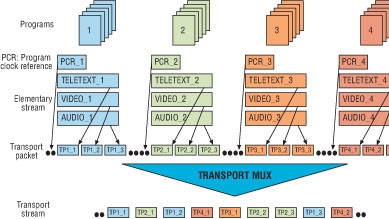New features for STBs and receivers

The main purpose of a transport stream is to ease the implementation of the FEC system.
Digital set-top boxes (STB) are available for cable, terrestrial and satellite broadcast media throughout the world. Virtually all of these systems incorporate a single tuner to select a particular channel or bouquet of programs of interest. The transport stream is then demultiplexed to allow viewers to select only one program to be displayed on the TV. The digital transport stream is very important to the STB and to some of the new features that will come in the future.
The digital transport stream
The main purpose of a transport stream is to ease the implementation of the forward error correction (FEC) system. The transport stream is the bitstream that carries all of the programming data. (See Figure 1.)
It has been defined in such a way as to minimize the processing effort required at a receiver when retreiving the coded program data.
Each program will consist of various items, typically video, audio in various languages and teletext. These programs are constructed out of what are known as elementary streams (ES), compressed datastreams bundled together with a common time reference — the program clock reference (PCR). In order for the ESs to be transmitted down the same channel they must be split up into small sections. These sections are called the transport packets (TP). These TPs are then multiplexed together to produce one bitstream — the transport stream (TS).
The packet is split into a header and a payload. The payload contains the PES and the program-specific information (PSI).
The professional video industry's #1 source for news, trends and product and tech information. Sign up below.
Demultiplexing is the process of extracting all of the useful information from the transport stream. The demux process must construct the program association table (PAT), the program map table (PMT), the network information table (NIT) and the conditional access table (CAT). It also must extract the compressed video data, audio data and any other data required from the transport stream for a particular video channel.
Chip level
At the heart of any STB is a single chip, known generally either as the central or demux processor. (See Figure 2.)
However with the technological advances in silicon from the semiconductor manufacturers it becomes easier and easier to integrate more and more features onto the same chip at virtually no extra cost. Already integrated in the demux processor are functions like tuner interface and control, SDRAM and FLASH memory interfaces, MPEG-2 decoding, Electronic Program Guide (EPG) graphics, smart card interfaces, IR remote and front panel control, audio and video signal processing and generation, etc.
New features
DSPs for advanced audio processing are being integrated; this means theater audio features such as Dolby Digital and SRS TruSurround. This is already a defacto mandatory requirement on DVD players, but also will be introduced into more STBs. ATAPI interfaces are being integrated for the easy connection of hard disk drives (HDD) and DVD ROM drives. Additional transport stream input blocks are being added and the inclusion of MPEG-2 encoders will soon be a reality. On top of all this the core processor speeds are increasing, bringing Internet browser functionality on the same chip within the realm of possibility.
Immediate STB advantages
What does all this mean to the viewer at home? Let's first consider the addition of an HDD with multiple transport stream input blocks. This would allow for simultaneous viewing and recording. In fact STMicroelectronics is developing a demux chip with three demux engines to allow viewers, for example, to view one program with time shift capability while at the same time recording a completely different program from another input. The demuxing is therefore performed on two transport stream inputs from the tuners, and one from the HDD. By storing the PES to disk and then watching the movie by decoding this disk information it is possible to take a break, then carry on viewing the movie when ready, skip the commercials by fast forwarding or skipping past them, or go back and see a piece of the movie again, even in slow motion.
Technology convergence advantages
As a general trend, and for product differentiation reasons, more features are being “bundled” in with the standard STB features of today. Broadband Internet is being made available for cable systems. Such features as DVD, CD-DA, MP3 and VCD functionality also can be easily integrated. The DVD data is simply stored in PES format; it has different error correction and decryption requirements and also needs some navigation software. However STBs have already been developed today with no additional silicon being needed on the main processing board. The digital audio features will allow for impressive theater sound effects. The STB can then be connected via an SPDIF output to a home audio amplifier system. Although, with the advances in digital audio amplification devices, the six channel amplification stages can also be integrated into the STB, as has already been done with some DVD players today.
HD STBs also will become more readily available as HDTV transmissions become more common. This should happen first in the United States, although the terrestrial transmission standards may delay things further. The better graphics and higher processor speed of STB technology will make Internet and games applications possible, however this won't become popular until many more home TVs are HD.
Mark Massel works for STMicroelectronics in technical marketing and is author of “Digital television, DVB-T COFDM and ATSC 8-VSB,” available either atwww.digitalTVbooks.comor fromwww.amazon.com.
